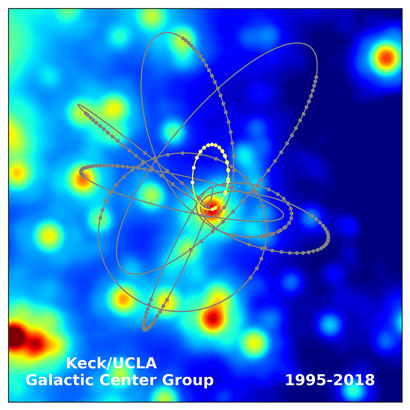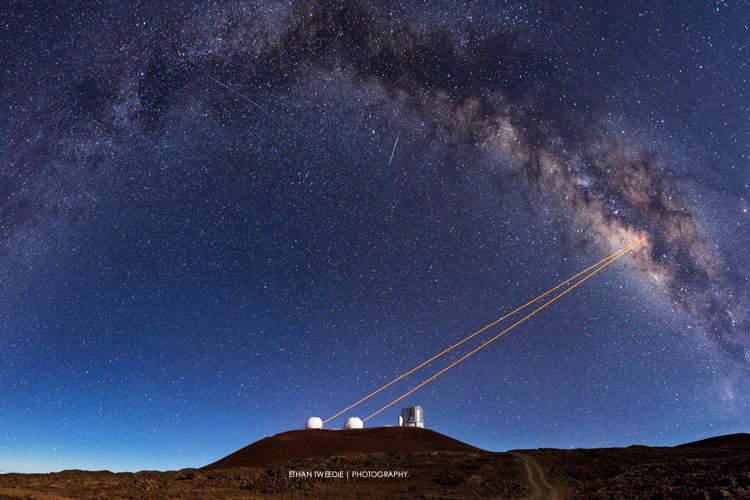Milky Way’s central black hole puts Einstein’s theories to the test
Astronomers see effect of monster black hole at the core of our galaxy on the orbits of nearby stars
July 25, 2019

An artistic visualization of the star S0-2 as it passes by the supermassive black hole at the galactic center, which has warped the geometry of space and time. As the star gets closer to the supermassive black hole, its light undergoes a gravitational redshift that is predicted by Einstein’s general theory of relativity. (National Science Foundation graphic by Nicolle R. Fuller)
University of California astronomers have tested Albert Einstein’s theories of relativity in the crucible of the monstrous black hole at the center of our Milky Way galaxy and found it rock solid. For now.
The team, led by UCLA astronomer Andrea Ghez, and with key analyses by UC Berkeley’s Jessica Lu, an assistant professor of astronomy, followed a star orbiting so close to the black hole that the light it gives off is affected by the black hole’s intense gravity. The effect, a gravitational redshift, matched exactly what Einstein’s theories of special and general relativity predict.
“The measurement of gravitational redshift around a supermassive black hole is really the beginning of a new era of testing general relativity,” said Lu, who began working with Ghez as a graduate student in 2003. “Our galactic center is a special place, a unique place, because we can study in detail the physics and astrophysics of a supermassive black hole. It is almost impossible to do that in any other galaxy.”
General relativity, which treats gravity as a warping of space and time, has been validated within our solar system and in the interactions between pairs of dense, solar-mass neutron stars, or pulsars. But tests around extremely massive objects — the black hole at the center of the galaxy is the mass of 4 million suns — could reveal where general relativity fails to explain the universe and modifications are necessary.
“We know that, at some point, general relativity must break down, because it doesn’t mesh with quantum mechanics, so it is just a constant hunt for where that breaking point is,” Lu said.
“We can absolutely rule out Newton’s law of gravity, (and) our observations are consistent with Einstein’s theory of general relativity,” said Ghez. “However, his theory is definitely showing vulnerability. It cannot fully explain gravity inside a black hole and, at some point, we will need to move beyond Einstein’s theory to a more comprehensive theory of gravity that explains what a black hole is.”
Ghez, Lu, lead author Tuan Do of UCLA and their colleagues published their findings today in the journal Science.
Redshift, blueshift
Black holes are black because light emitted at the surface, or event horizon, cannot escape: It doesn’t have enough energy. The light falls back and orbits the black hole before eventually disappearing inside, so all we see is black.
The UC team followed the star SO-2, which is far enough from the event horizon to still be visible. Nevertheless, the general theory of relativity says that the light it emits will lose energy and become redder by the time it reaches Earth, which is about 26,000 light years from the galactic center.
In addition, the special theory of relativity, which explains why people traveling at different speeds see time and space differently, says that the speed of the star will cause the light to be bluer when moving toward us and redder when moving away.
The team, using 24 years of observations, saw both effects. When SO-2 got closest to the black hole — approximately 120 times the distance between Earth and our sun, or 120 astronomical units — the light lost about 0.03 percent of its energy while climbing out of the gravitational well of the black hole.
Also, at closest approach, when it was traveling at 16 million miles per hour — nearly 3 percent of the speed of light — the redshifts and blueshifts perfectly matched the predictions of special relativity. Because of general relativity, SO-2 was traveling 107 miles per hour faster than simple Newtonian gravity would predict, based on Isaac Newton’s 17th century theory.

The orbits of stars around the supermassive black hole at the center of our galaxy. The star S0-2 is the first star with enough measurements to test general relativity around a supermassive black hole. (Image courtesy of Keck/UCLA Galactic Center Group)
Similar results were reported a year ago by a competing team led by Reinhard Genzel, an astrophysicist at UC Berkeley and director of the Max Planck Institute for Extraterrestrial Physics in Germany. Those results came before three key events in the 16-year orbit of SO-2: its closest approach to the black hole, referred to as SagA* (found in the direction of the southern constellation Sagittarius); its fastest and most blue-shifted motion relative to Earth; and its slowest, most red-shifted motion relative to Earth.
The new results include these three events in the analysis, providing a better check on general relativity and making it the most detailed study ever conducted on supermassive black holes and Einstein’s theory of general relativity.
“The star SO-2 is orbiting on a very eccentric orbit: At its farthest from SagA*, it’s 16.5 times farther than its closest approach,” Lu said. “It really dips in, whips around the black hole and then heads back out and hangs out far away for quite a while. That period where it passes through closest approach is very short, but very important to measure.”
The measurements also provided a more accurate mass for the black hole at the center of the galaxy — 3.984 million times the mass of the sun — and pinpointed its distance at 7,971 parsecs (25,916 light years).
Lu led the team’s astrometry group, which precisely measured the position in the sky of SO-2 relative to SagA* using the twin 10-meter telescopes at the Keck Observatories in Hawaii. Those telescopes are equipped with adaptive optics to remove blur from the atmosphere. Ghez and Do led the group that measured the red and blue shifts of light from SO-2. Together, these data provided the three-dimensional position of the star’s orbit necessary to test relativity.

Lasers from the twin Keck telescopes atop Maunakea in Hawaii propagate in the direction of the galactic center, the location of the supermassive black hole at the core of the Milky Way Galaxy. Each laser, part of the adaptive optics system, creates an artificial star that can be used to correct for the blurring due the Earth’s atmosphere, allowing precise tracking of the motion of stars around the black hole. (Photo courtesy of Ethan Tweedie, 2013)
The team is eager to again put relativity to the test by astrometrically measuring the precession of the orbit of SO-2 — that is, a gradual rotation of the orbital plane predicted by general relativity. A key early test of relativity was its explanation for an anomaly in the precession of the orbit of Mercury, which turned out to be due to the warping of space-time by the sun’s gravity.
“The stars around SagA*, the supermassive black hole in our galaxy, should also show this orbital precession, just like Mercury,” she said. “We have never measured that around a supermassive black hole before. It will be another probe of general relativity.”
Co-authors with Lu, Ghez and Do are researchers from Japan, Germany, France, Spain and the United States. The National Science Foundation has supported the UCLA Galactic Center Group for the last 25 years, with additional funding from the W. M. Keck Foundation, Gordon and Betty Moore Foundation and Heising-Simons Foundation.